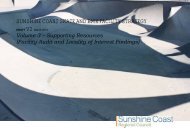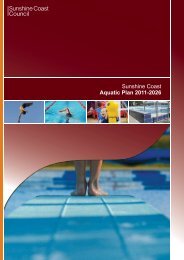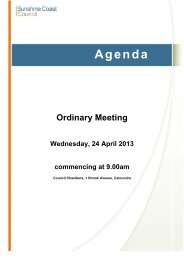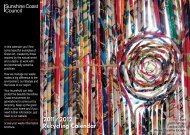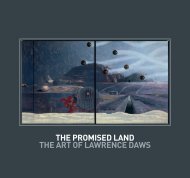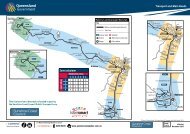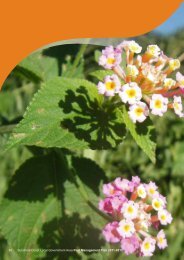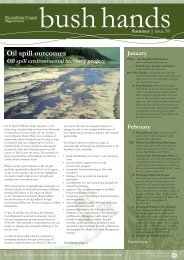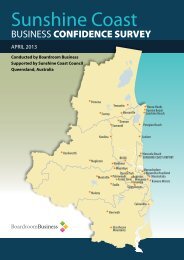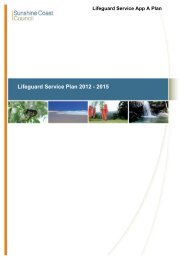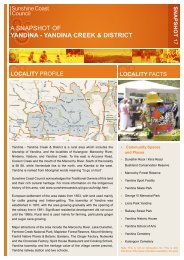Sunshine Coast Council Community Plan 2011
Sunshine Coast Council Community Plan 2011
Sunshine Coast Council Community Plan 2011
Create successful ePaper yourself
Turn your PDF publications into a flip-book with our unique Google optimized e-Paper software.
<strong>Sunshine</strong> <strong>Coast</strong><br />
our vision for 2030
the region<br />
N<br />
Kin Kin<br />
Boreen<br />
Point<br />
Cooran<br />
Pomona<br />
Cooroy<br />
Tewantin<br />
Noosa Heads<br />
<strong>Sunshine</strong><br />
Beach<br />
Eumundi<br />
Peregian<br />
Beach<br />
Coolum<br />
Yandina<br />
Kenilworth<br />
Bli Bli<br />
Marcoola<br />
Mapleton<br />
Nambour<br />
Mudjimba<br />
Montville<br />
Buderim<br />
Maroochydore<br />
Mooloolaba<br />
Maleny<br />
Mooloolah<br />
Sippy<br />
Downs<br />
Kawana<br />
Dicky<br />
Beach<br />
Landsborough<br />
Caloundra<br />
Golden Beach<br />
Beerwah<br />
Stanmore<br />
Glasshouse<br />
Mountains<br />
Beerburrum<br />
Bribie<br />
Island<br />
1<br />
<strong>Sunshine</strong> <strong>Coast</strong> <strong>Community</strong> <strong>Plan</strong>
contents<br />
Context<br />
Introduction 3<br />
Indigenous history 4<br />
The early Europeans 5<br />
The 20th century 6<br />
Becoming the <strong>Sunshine</strong> <strong>Coast</strong> 7<br />
Recent developments 8<br />
Lessons from the past 9<br />
The region today 10<br />
A community of communities 11<br />
Big issues for the future 12<br />
Vision and Values<br />
Our vision 13<br />
Our values 14<br />
Our principles 15<br />
Aspirations<br />
Our aspirations 16<br />
Changing our thinking 17<br />
Enjoying an active lifestyle 18<br />
Well managed growth 19<br />
Becoming ecologically sustainable 20<br />
Developing the economy 21<br />
Ensuring social cohesion 22<br />
Being connected 23<br />
Tapping into our creativity 24<br />
The way forward<br />
Next steps and partnerships 25<br />
Sustainability indicators 26<br />
Areas for improvement 27<br />
<strong>Council</strong> response 29<br />
Queensland Government response 30<br />
Published with the assistance of<br />
<strong>Sunshine</strong> <strong>Coast</strong> <strong>Council</strong>, May <strong>2011</strong><br />
www.sunshinecoast.qld.gov.au <strong>Sunshine</strong> <strong>Coast</strong> <strong>Community</strong> <strong>Plan</strong> 2
introduction<br />
The <strong>Sunshine</strong> <strong>Coast</strong>’s first <strong>Community</strong> <strong>Plan</strong><br />
documents our community’s vision, values<br />
and aspirations for the next 20 years.<br />
It recognises that we are a community of<br />
communities and acknowledges and respects<br />
our unique environment, our rich heritage,<br />
our diverse people and our shared values.<br />
The plan sets the context for the development<br />
and growth of our region, the protection<br />
of our ecosystems, improvements to our<br />
infrastructure and supports the wellbeing of<br />
our people.<br />
It is a living document, a starting point, from<br />
which our community can now develop solid<br />
strategies and actions for the future. As such,<br />
the plan’s key messages and aspirations need<br />
to be carefully considered by all decisionmakers<br />
across the region in the development<br />
of their strategic plans.<br />
Preparing the plan has involved considerable<br />
input from local residents. It began with an<br />
extensive analysis of feedback obtained over<br />
the last five years from previous research<br />
and community consultation activities.<br />
Further information was derived from an<br />
independent survey of 800 people and a<br />
two-day community conference held in<br />
October 2010, which was attended by a wide<br />
range of community representatives and<br />
stakeholders. Following the conference, the<br />
community had the opportunity to comment<br />
on the plan before it was presented to <strong>Council</strong><br />
for adoption in May <strong>2011</strong>.<br />
What has become clear is the community’s<br />
commitment to the <strong>Sunshine</strong> <strong>Coast</strong> becoming<br />
Australia’s most sustainable region. To<br />
become more sustainable we must protect<br />
our precious natural assets and lifestyle,<br />
build our economy, create a fairer society<br />
and seize new opportunities as they arise.<br />
Our community appreciates that there are<br />
difficult choices to make and major debates<br />
ahead as we try and balance the issues of<br />
economic development, environmental<br />
protection and social justice. Our community<br />
has made it clear that it wants its voice to be<br />
heard in these future debates.<br />
We all have a responsibility and a role to play<br />
in the future success and sustainability of<br />
our region. This will require a collaborative<br />
approach involving local businesses, notfor-profit<br />
organisations, community groups,<br />
residents associations, and all levels of<br />
government. I encourage everyone to get<br />
involved and take an active role in shaping<br />
our future.<br />
I would like to thank everyone who has<br />
contributed towards the development of<br />
this plan. Thank you also to the many<br />
local people who have brought it to life by<br />
contributing images through the Zooming<br />
into 2030 photographic project.<br />
Cr Bob Abbot<br />
Mayor<br />
3<br />
<strong>Sunshine</strong> <strong>Coast</strong> <strong>Community</strong> <strong>Plan</strong><br />
<strong>Community</strong> Conference October 2010. Image courtesy of <strong>Sunshine</strong> <strong>Coast</strong> <strong>Council</strong>.
indigenous history<br />
Our region’s development and industry are<br />
relatively recent but our Aboriginal history<br />
dates back many thousands of years and<br />
evidence of that time remains with us today.<br />
The <strong>Sunshine</strong> <strong>Coast</strong> is rich in indigenous<br />
heritage, with numerous sites steeped in<br />
cultural significance and a long oral history<br />
which is still very much alive today.<br />
The Gubbi Gubbi people lived along the coast<br />
and inland on the adjacent ranges, while the<br />
Jinibara people lived in the south-western<br />
parts of the region.<br />
These people had an excellent knowledge of<br />
the land and they hunted the ranges, fished<br />
the rivers and lakes, and gathered seafood<br />
from the ocean for many thousands of years.<br />
The Gubbi Gubbi and Jinibara walked the<br />
country in family groups, coming together<br />
when food was plentiful. Probably the<br />
most significant and largest of these social<br />
gatherings were the Bunya festivals in the<br />
Blackall Ranges where people from all over<br />
the region and beyond gathered to sing<br />
and dance, exchange news, settle disputes,<br />
arrange marriages and undertake<br />
initiation ceremonies.<br />
Tribal boundaries were marked by rivers<br />
and mountain ranges and a number of major<br />
trading routes passed though the <strong>Sunshine</strong><br />
<strong>Coast</strong>. Today, many Aboriginal words are<br />
still used to describe parts of our region’s<br />
geography and landscape. These include<br />
Cooroy, place of the grey forest possum;<br />
Nambour which comes from the Gubbi Gubbi<br />
name for the red flowering grevillea; Beerwah<br />
which means eagle; and Bli Bli which refers to<br />
the flying fox.<br />
The coming of Europeans changed the<br />
lives of the traditional owners forever.<br />
Following the establishment of the penal<br />
colony in Redcliffe in 1824, it is estimated<br />
that up to 3000 Aboriginal people died as a<br />
result of the expansion of white settlement<br />
into the region.<br />
Today, the indigenous community on the<br />
<strong>Sunshine</strong> <strong>Coast</strong> includes Traditional Owners,<br />
South Sea Islanders and historical Aboriginal<br />
peoples. The South Sea Islanders were<br />
brought here in the early days of European<br />
settlement and forced to work on farms.<br />
Most of the historical Aboriginal peoples<br />
have moved into the area since 1965 when<br />
the Aboriginal and Torres Strait Islander Act<br />
repealed previous laws, dating from 1897,<br />
which had restricted indigenous people’s<br />
rights to own land, travel and vote.<br />
“In 2030<br />
I hope that<br />
we celebrate our<br />
rich and diverse<br />
cultures.”<br />
Context<br />
<strong>Sunshine</strong> <strong>Coast</strong> <strong>Community</strong> <strong>Plan</strong> 4<br />
Image courtesy of Corrie Wright.
the early europeans<br />
Context<br />
Lieutenant James Cook observed the peaks<br />
of the Glasshouse Mountains from his ship,<br />
The Endeavour, in 1770. He named them<br />
after the furnace cones of the glass<br />
factories in his native Yorkshire, which<br />
they resembled.<br />
Some 29 years later, Matthew Flinders<br />
conducted a survey of the Glasshouse<br />
Mountains from the summit of Mount<br />
Beerburrum.<br />
The first Europeans to live on the <strong>Sunshine</strong><br />
<strong>Coast</strong> were drawn to the region’s abundant<br />
timber and grazing potential.<br />
The Mooloolah River mouth and harbour<br />
were surveyed and charted in 1861 and Tom<br />
Petrie explored the region in the early 1860s.<br />
The first settlers came to Landsborough a<br />
decade later. In 1875, the first house was<br />
constructed at Caloundra by Robert Bulcock.<br />
His nephew, novelist Vance Palmer, wrote<br />
of the early days of settlement in his classic<br />
novel The Passage.<br />
Signs of the region’s agricultural potential<br />
began to emerge in the late 1860s, and in<br />
1876 the first sugar mill was established<br />
in Buderim. In the decades that followed,<br />
Buderim farmers turned to large-scale<br />
fruit production.<br />
To the north, the discovery of gold in Gympie<br />
in 1867 provided a significant catalyst for<br />
the development of Tewantin and Noosa.<br />
The road connecting Brisbane to Gympie<br />
was completed in 1868 and by November of<br />
that year, Cobb & Co. coaches were carrying<br />
passengers, mail, goods and gold between<br />
the two centres.<br />
Bankfoot House, a heritage residence set in<br />
the Glasshouse Mountains and now owned by<br />
<strong>Council</strong>, was built as an accommodation stop<br />
for coaches travelling the old<br />
Gympie Road.<br />
The development of the Brisbane to Gympie<br />
railway in the late 1800s had a significant<br />
impact on development and settlement<br />
patterns. It opened up the hinterland and<br />
spawned the railway towns of Beerburrum,<br />
Beerwah, Mooloolah, Nambour, Yandina,<br />
Eumundi, Cooroy, Pomona and Cooran.<br />
The establishment of the Moreton Central<br />
Sugar Mill in 1897 saw Nambour emerge as a<br />
centre of industry and business.<br />
Around the turn of the century, the dairy<br />
industry became dominant in the Kenilworth<br />
and Belli areas and agriculture had begun<br />
to thrive on the Blackall Range. Mapleton<br />
had become a leading citrus-producing area<br />
by the early 1900s and citrus orchards and<br />
pineapple farms covered the plateau at<br />
Montville. In the decades that followed, this<br />
area became known for macadamia nuts and<br />
avocados as well as its dairy industry.<br />
5<br />
<strong>Sunshine</strong> <strong>Coast</strong> <strong>Community</strong> <strong>Plan</strong><br />
Harry Heddon with team of horses and cane truck on Maroochy river property. Image courtesy of <strong>Sunshine</strong> <strong>Coast</strong> <strong>Council</strong>.
the 20 th century<br />
The sale of residential allotments in 1908<br />
marked the beginning of the development of<br />
Maroochydore as a seaside resort.<br />
Coolum had also become home to a number<br />
of settlers, and between 1922 and 1925 the<br />
first genuinely trafficable road providing<br />
vehicle access from Coolum to Yandina was<br />
constructed. Cane farming provided the main<br />
source of income in the area until the advent<br />
of tourism in the 1960s.<br />
Before the first bridges over Doonella Lake<br />
and Weyba Creek were built in 1929, Gympie<br />
Terrace and Noosa Heads could only be<br />
reached by boat. Once Noosaville and Noosa<br />
Heads became accessible by motor car, the<br />
local tourism industry began to expand.<br />
The region’s population grew throughout the<br />
1930s as roads improved and automobiles<br />
became more reliable and affordable.<br />
There has always been a strong nature<br />
preservation and conservation movement in<br />
the region advocating the protection of natural<br />
areas and the enlargement of conservation<br />
tenures. The original rainforest areas of the<br />
Noosa National Park were gazetted in 1930<br />
and since then other national parks have been<br />
established in the region including Kondalilla<br />
Falls in 1945, the Mooloolah River National<br />
Park in 1960, the Great Sandy Park in 1971,<br />
and the Glasshouse Mountains in 1994.<br />
World War II brought an influx of Australian<br />
and American armed services personnel to<br />
Caloundra and Bribie Island, while the<br />
beaches from Noosa to Caloundra hosted<br />
a series of military camps to guard our<br />
coastline from attack.<br />
After the war there was a building boom<br />
on the <strong>Coast</strong>, with the well-heeled from<br />
surrounding areas building holiday homes<br />
in prime beachfront positions. The real<br />
breakthrough for tourism, however, arrived<br />
with the completion of the David Low Way<br />
from Maroochydore to Noosa in 1959.<br />
The opening of the Maroochy Airport in 1961<br />
marked another major milestone for the<br />
region. This facility has undergone significant<br />
expansion since and almost half a century on,<br />
the renamed <strong>Sunshine</strong> <strong>Coast</strong> Airport has had<br />
close to a million passengers pass through<br />
its gates.<br />
The 1960s marked the start of a new era for<br />
the region with major social changes resulting<br />
from the movement away from a hinterlandbased<br />
rural farming economy to a new focus<br />
on coastal development, accompanied by the<br />
growth of the tourism industry.<br />
Context<br />
“In 2030 I hope<br />
the commercial<br />
fishing fleet is still<br />
operating from<br />
Mooloolaba.”<br />
<strong>Sunshine</strong> <strong>Coast</strong> <strong>Community</strong> <strong>Plan</strong> 6<br />
Image courtesy of Bill Sanderson.
ecoming the sunshine coast<br />
Context<br />
The name ‘<strong>Sunshine</strong> <strong>Coast</strong>’ was launched<br />
in December 1958 at the inaugural dinner<br />
of the <strong>Sunshine</strong> <strong>Coast</strong> branch of the Real<br />
Estate Institute of Queensland. The institute<br />
was arguing to replace the term Near North<br />
<strong>Coast</strong>, which the branch considered was not<br />
sufficiently distinctive and had no significance<br />
for southerners. The name was officially<br />
adopted in November 1966 to cover the<br />
Landsborough, Maroochy and Noosa shires.<br />
During the 1960s, the <strong>Sunshine</strong> <strong>Coast</strong>’s<br />
surfing culture started to flourish, as a<br />
growing number of board riders discovered<br />
the region’s pristine coastline and great beach<br />
breaks. Elsewhere in the region, pockets of the<br />
hinterland were becoming a haven for people<br />
seeking an alternative lifestyle as a growing<br />
number of people turned their backs on the<br />
city and moved to the country.<br />
In 1976, the combined population of the<br />
Noosa, Maroochydore and Caloundra shires<br />
totalled 62,673. Just 15 years later, that figure<br />
had grown to more than 167,000. By 2010<br />
that number had almost doubled again, with<br />
330,000 residents calling the region home.<br />
The <strong>Coast</strong>’s own daily newspaper, the<br />
<strong>Sunshine</strong> <strong>Coast</strong> Daily, began rolling off the<br />
presses in 1980, coinciding with a surge in<br />
the region’s growth and development. The<br />
<strong>Sunshine</strong> <strong>Coast</strong> Environment <strong>Council</strong> was<br />
also established in the same year.<br />
While the David Low Way had opened up<br />
the ribbon of coastal subdivisions, further<br />
urbanisation led to the construction of the<br />
<strong>Sunshine</strong> Motorway. The first section between<br />
the Bruce Highway and Nicklin Way opened<br />
in 1988, followed by the stretch from Nicklin<br />
Way to David Low Way two years later.<br />
7<br />
<strong>Sunshine</strong> <strong>Coast</strong> <strong>Community</strong> <strong>Plan</strong><br />
Image courtesy of Andrew Cook.
ecent developments<br />
The <strong>Sunshine</strong> <strong>Coast</strong> University College<br />
was founded at Sippy Downs in 1994, and<br />
achieved full university status in 1998. The<br />
University of the <strong>Sunshine</strong> <strong>Coast</strong> now creates<br />
new opportunities for the region’s residents<br />
and the local economy.<br />
Population growth also led to the<br />
development of new shopping centres across<br />
the <strong>Coast</strong> and the region’s largest, <strong>Sunshine</strong><br />
Plaza at Maroochydore, opened in 1995.<br />
Starting in the 1980s, local architects and<br />
designers had begun to experiment with<br />
environmentally sensitive designs. By the<br />
1990s they had earned a national reputation<br />
for their innovative buildings which were<br />
helping to define the urban character of<br />
the <strong>Coast</strong>.<br />
The significance of our regional ecosystems<br />
and the efforts the community has put into<br />
preserving these systems has received<br />
significant international recognition in the<br />
last two decades. In 1993, the Pumicestone<br />
Passage was included in the declaration of the<br />
Moreton Bay Marine Park and later that year<br />
the Park was recognised as an internationally<br />
significant wetland and bird habitat under<br />
the RAMSAR Convention.<br />
Fourteen years later, Noosa Shire was<br />
declared Queensland’s first UNESCO<br />
Biosphere Reserve in recognition of the<br />
area’s biodiversity and the local community’s<br />
efforts to combine economic and social<br />
development with environmental protection.<br />
In March 2008, almost sixty years from<br />
the Real Estate Institute of Queensland’s<br />
proposal calling for the region to be renamed<br />
the <strong>Sunshine</strong> <strong>Coast</strong>, the <strong>Sunshine</strong> <strong>Coast</strong><br />
Regional <strong>Council</strong> was created following the<br />
State Government’s Local Government<br />
reform process which merged Caloundra<br />
City with the former shires of Maroochy and<br />
Noosa to form a single local government.<br />
Context<br />
“In 2030<br />
I don’t want to<br />
live in a place<br />
that resembles a<br />
sardine can!”<br />
<strong>Sunshine</strong> <strong>Coast</strong> <strong>Community</strong> <strong>Plan</strong> 8<br />
Image courtesy of Taylah Hughes.
lessons from the past<br />
Context<br />
To effectively plan for the future we must<br />
understand our history. Our past is important<br />
– we need to respect it, learn from it and<br />
conserve what is important to us about it.<br />
Our cultural heritage is woven into the fabric<br />
of our everyday life. It has determined the<br />
look and feel of the landscape we live in and<br />
left us with an environmental legacy that<br />
includes significant areas of land preserved<br />
as national parks, but other areas that are<br />
highly degraded. There is much we can learn<br />
about sustainability from Aboriginal culture.<br />
The townships and urban areas peppered<br />
throughout the <strong>Sunshine</strong> <strong>Coast</strong> are historic<br />
places with their own distinct features,<br />
architecture and sense of identity. We need<br />
to nurture these places and recognise their<br />
unique heritage. We also need to clearly<br />
define how we are going to do this and who is<br />
responsible for conserving our heritage.<br />
While rail opened up the <strong>Sunshine</strong> <strong>Coast</strong><br />
hinterland in the 19th century to other parts<br />
of Queensland, getting around our region is<br />
still a challenge for us today. In the decades<br />
ahead we will need to improve our public<br />
transport linkages and overcome our reliance<br />
on the motor car.<br />
Many of the environmental, economic and<br />
social challenges the region faces are the<br />
result of the last four decades of exponential<br />
population growth and associated<br />
development. This has seen the region’s<br />
essential and social infrastructure stretched<br />
almost to breaking point and housing<br />
becoming less affordable.<br />
The <strong>Sunshine</strong> <strong>Coast</strong> has been viewed by<br />
many as the ‘playground’ for South East<br />
Queensland, due to the diversity of leisure,<br />
tourism and recreation opportunities<br />
available. While the influx of visitors and<br />
holidaymakers contributes significantly to<br />
our economy, it helps drive the increased<br />
demand for infrastructure, which, if not<br />
well managed, can potentially compromise<br />
the region’s environmental values.<br />
Managing the impacts of growth and<br />
increasing population remains one of our<br />
biggest challenges.<br />
On the positive side, we have a strong history<br />
of community activism and social enterprise<br />
within the region and over the coming<br />
decades we need to find new ways to harness<br />
‘people energy’ to help address the major<br />
environmental and social challenges ahead.<br />
At the same time, we also need to broaden<br />
our economic base from the current<br />
reliance on tourism, retail and construction<br />
industries, so that we have jobs for our<br />
expanding population and our young people<br />
are not forced to leave the <strong>Coast</strong> looking for<br />
work. To do this we need to look at ways<br />
in which we can attract new investment to<br />
the region by drawing on the creativity and<br />
innovation of our entrepreneurs, investing in<br />
smart sustainable industries, and securing<br />
our digital future. Similarly, we need to find<br />
ways to reinvigorate our rural sector which,<br />
for so long, was the backbone of our economy.<br />
While being conscious of our historical legacy,<br />
we must also be aware of new and emerging<br />
challenges such as climate change and peak<br />
oil. Recent studies by the International Panel<br />
on Climate Change show that the <strong>Sunshine</strong><br />
<strong>Coast</strong> is one of the most vulnerable areas in<br />
Australia to the impacts of climate change.<br />
<strong>Community</strong> adaption strategies will become<br />
increasingly important for our region in the<br />
century ahead.<br />
This <strong>Community</strong> <strong>Plan</strong> will help us build on<br />
our past and encourage us to embrace our<br />
potential so we can look to the decades ahead<br />
with optimism and a clear sense of who we<br />
are, where we have come from, and where we<br />
are going.<br />
9<br />
<strong>Sunshine</strong> <strong>Coast</strong> <strong>Community</strong> <strong>Plan</strong>
the<br />
The <strong>Sunshine</strong> <strong>Coast</strong> region covers an area of<br />
more than 3000 square kilometres, including<br />
113 square kilometres of waterways. It has<br />
more than 200 kilometres of coastline, more<br />
than 4000 kilometres of roads, nearly 800<br />
kilometres of bikeways and more than 13,000<br />
hectares of parks and bushland.<br />
The <strong>Sunshine</strong> <strong>Coast</strong> is one of the fastest<br />
growing regions in Australia, with people<br />
from other parts of Queensland, interstate<br />
and overseas drawn to our wonderful climate,<br />
enviable lifestyle, natural attributes and<br />
obvious potential.<br />
The region is home to 330,000 people and it<br />
is anticipated that at least 200,000 additional<br />
residents will settle on the <strong>Sunshine</strong> <strong>Coast</strong><br />
over the next 20 years.<br />
With its diverse geographical, geological and<br />
topographical features and conservation<br />
ethic, the <strong>Sunshine</strong> <strong>Coast</strong> is known as one<br />
of the most bio-diverse regions in Australia,<br />
and it boasts a large array of life forms,<br />
ecosystems and natural assets. However,<br />
a range of pressures are taking a toll on<br />
native habitat and wildlife, and the region<br />
is currently experiencing a net habitat<br />
loss. The <strong>Sunshine</strong> <strong>Coast</strong> is potentially<br />
at a critical threshold, with habitats and<br />
remnant vegetation being cleared faster<br />
“In 2030 I want to<br />
see the best and<br />
brightest young<br />
people staying on<br />
the coast”<br />
than they are being replaced. It is estimated<br />
that a little more than approximately one<br />
third of the total <strong>Sunshine</strong> <strong>Coast</strong> region<br />
consists of native vegetation, with around<br />
half of this vegetation on private land. Every<br />
encouragement must be given to private<br />
landholders to conserve and rehabilitate<br />
areas of native vegetation on their<br />
property, through such means as Land<br />
for Wildlife, Nature Refuges and<br />
Conservation Agreements.<br />
Analysis of the latest census data shows<br />
that we have a smaller proportion of people<br />
earning more than $1000 per week and a<br />
larger proportion of people earning less than<br />
$400 per week than the Queensland average.<br />
These figures reinforce the importance<br />
of creating new job opportunities and<br />
addressing affordability issues.<br />
Like many so-called ‘sea change’ communities<br />
around Australia, our demographic profile<br />
shows a lower proportion of families and a<br />
higher proportion of people over 50 than<br />
the Queensland average. This reflects our<br />
popularity as a place for people to retire. This<br />
ageing of the population brings opportunities<br />
but also a number of challenges in terms of<br />
service provision and economic vitality over<br />
the next 20 years. It also raises the question<br />
of how we ensure that the <strong>Sunshine</strong> <strong>Coast</strong><br />
remains a vibrant place for families and<br />
young people to live.<br />
Recently published regional data from<br />
Queensland Health indicates that the health<br />
of people living on the <strong>Sunshine</strong> <strong>Coast</strong> is<br />
very similar to the Queensland average. On<br />
the positive side, 57% of adults engage in<br />
sufficient physical activity for health benefits;<br />
however, 53% of adults are overweight. 30%<br />
have high cholesterol or high blood pressure,<br />
and 8.1% have diabetes. So another challenge<br />
for most of us is how to achieve a healthy<br />
less-sedentary lifestyle.<br />
Context<br />
<strong>Sunshine</strong> <strong>Coast</strong> <strong>Community</strong> <strong>Plan</strong> 10<br />
Image courtesy of Ben Everingham.
a community of communities<br />
Context<br />
Our region has developed as a community<br />
of communities. The individuality of our<br />
towns and villages is part of our character<br />
and one of our points of difference from<br />
other regions in South East Queensland.<br />
We are proud of the diversity and unique<br />
differences that exist between each of the<br />
<strong>Sunshine</strong> <strong>Coast</strong> communities.<br />
Over time our communities have proved<br />
themselves to be resilient and able to<br />
overcome natural disasters and economic<br />
downturns. We need to maintain and build<br />
upon this resilience.<br />
We need to preserve the history, identity<br />
and character of these towns and areas in<br />
order that our centres continue to be vibrant,<br />
friendly and safe. This will mean that each of<br />
our communities will contribute in their own<br />
way to the essence and strength of the region.<br />
We also need to ensure that our towns and<br />
villages do not dominate or destroy the<br />
natural environment and our urban areas<br />
continue to be surrounded by open space and<br />
productive farmland.<br />
We are lucky to live in a biodiversity hot spot<br />
where there are many different species of<br />
animals and plants. However, many of these<br />
species are under threat and while previous<br />
generations of conservationists have worked<br />
hard to protect these communities of animals<br />
and plants, one of our key challenges is to<br />
continue this tradition of environmental<br />
custodianship.<br />
Local entrepreneurs and small businesses<br />
are the backbone of our communities. We<br />
will continue to support them to prosper and<br />
grow, thus retaining local knowledge, building<br />
skills and employment in the region.<br />
We also recognise the great benefits that flow<br />
from the positive interaction of different<br />
generations and the important role that<br />
families play in our community. We will<br />
work hard to provide support to families and<br />
develop opportunities for mentoring and the<br />
exchange of ideas between young and old.<br />
11<br />
<strong>Sunshine</strong> <strong>Coast</strong> <strong>Community</strong> <strong>Plan</strong><br />
Image courtesy of Alan Rogers.
i f<br />
It is an enormous challenge to retain the<br />
best of what we have now, while embracing<br />
change and opportunity as our region<br />
continues to grow.<br />
The region’s liveability, its strong sense of<br />
community, its character and environment<br />
are central to our future success and these<br />
elements must be protected and maintained.<br />
The community understands that an<br />
expanding population will increase demand<br />
for services and infrastructure — particularly<br />
those that provide for our health and<br />
wellbeing. The challenge for all levels of<br />
government is to provide essential services<br />
and infrastructure in a timely manner.<br />
At the same time we need to be creative<br />
and broaden the economy by attracting<br />
investment and generating jobs in<br />
sectors that complement our lifestyle<br />
and environment.<br />
Investment in education and training are<br />
significant issues for the future, as well as the<br />
ability to move around the region safely and<br />
easily with quality public transport systems<br />
in place.<br />
<strong>Sunshine</strong> <strong>Coast</strong> residents are united in their<br />
support for development that creates a<br />
sustainable region. In this regard, how well<br />
we manage our projected future growth is the<br />
key issue.<br />
Decision-makers need to recognise that the<br />
majority of locals are not convinced that<br />
the region can easily sustain the South<br />
East Queensland Regional <strong>Plan</strong>’s projected<br />
population target of about half a million<br />
people by 2031.<br />
Context<br />
The big issues facing the <strong>Sunshine</strong> <strong>Coast</strong> community include:<br />
• Ensuring our health and wellbeing<br />
• Population growth<br />
• Providing essential services and<br />
infrastructure<br />
• Access to excellent educational<br />
opportunities<br />
• Living in a safe community<br />
• Improving and better coordinating our<br />
public transport<br />
• Adopting sustainable technologies<br />
like solar power, collecting rain water<br />
and recycling<br />
• Providing facilities for sporting,<br />
recreation and community activities<br />
• Supporting existing businesses<br />
• Diversifying the economy and creating<br />
employment opportunities<br />
• Protecting our waterways and<br />
coastal foreshores<br />
• Enhancing our natural environment<br />
and its biodiversity<br />
• Ensuring public areas are accessible for<br />
older people and people with a disability<br />
• Cost of living<br />
• Keeping government and utility fees<br />
and charges as low as possible<br />
• Maintaining our vibrant lifestyle<br />
• Identifying and protecting our<br />
cultural heritage<br />
• Supporting families<br />
<strong>Sunshine</strong> <strong>Coast</strong> <strong>Community</strong> <strong>Plan</strong> 12
our vision<br />
At the <strong>Community</strong> Conference in October 2010, delegates endorsed a vision of<br />
the <strong>Sunshine</strong> <strong>Coast</strong> becoming Australia’s most sustainable region. By deliberately<br />
aligning the <strong>Community</strong> <strong>Plan</strong> and <strong>Council</strong>’s Corporate <strong>Plan</strong>, delegates were<br />
seeking to unify the region behind a common strategy and provide a strong basis<br />
for us to grow. Our vision is:<br />
Vision & Values<br />
to be Australia’s most<br />
sustainable region<br />
– vibrant, green, diverse<br />
We have adopted the Brundtland definition of sustainability which states:<br />
“Sustainable development is development that meets the needs of the present<br />
without compromising the ability of future generations to meet their own needs.”<br />
Brundtland Commission – Report to the World Commission on Environment and Development, 1987.<br />
13<br />
<strong>Sunshine</strong> <strong>Coast</strong> <strong>Community</strong> <strong>Plan</strong><br />
Image courtesy of Tasha Carthy.
our values<br />
As a community, we believe it is important to establish a set of values that we can all live by<br />
regardless of our age, religion or cultural background.<br />
The values we have identified to achieve our vision are:<br />
• Integrity, honesty and openness<br />
• Fairness and equity<br />
• Generosity of spirit<br />
• Acceptance and respect for others<br />
• Courage to make the difficult decisions<br />
Vision & Values<br />
By adopting these values we aim to create a place where people have a sense of identity<br />
and belonging, where everyone takes responsibility for their own actions and gives<br />
others a fair go.<br />
We hope these values will inspire our leaders to support the building of a caring, ethical<br />
and resilient society where we live in harmony with each other and the environment.<br />
<strong>Sunshine</strong> <strong>Coast</strong> <strong>Community</strong> <strong>Plan</strong> 14<br />
Image courtesy of Graham Gillies.
our principles<br />
The following principles will help guide our journey towards sustainability and ensure<br />
the identity and character of the region is retained.<br />
Vision & Values<br />
• We are committed to understanding our<br />
history and not repeating past mistakes<br />
• We will make informed decisions for<br />
the benefit of all, based upon research,<br />
community deliberation and<br />
common sense<br />
• We will act dynamically to improve<br />
the future<br />
• We will preserve our unique biodiversity<br />
and seek to restore the productivity of<br />
degraded landscapes<br />
• We will achieve long-term<br />
economic sustainability based upon<br />
environmentally sound development<br />
• We will live within our means and seek<br />
to minimise our environmental footprint<br />
• We will build upon the individuality<br />
and character of our communities<br />
• We recognise the value of partnerships<br />
to help us achieve our common goals<br />
In short: we won’t do things today that stuff things up for others in the future!<br />
15<br />
<strong>Sunshine</strong> <strong>Coast</strong> <strong>Community</strong> <strong>Plan</strong><br />
Image courtesy of Sandy Johnson.
our aspirations<br />
Sustainability cannot be developed externally<br />
and imposed on a community from outside.<br />
To be successful, it must be embraced by<br />
people at the grass roots level and adapted to<br />
reflect that particular community’s history,<br />
values and aspirations.<br />
Implicit in our vision is a realisation that we<br />
need to examine and challenge our current<br />
practices and models of behaviour. We must<br />
be aware of the increasing stresses we are<br />
placing on our economic, environment and<br />
social systems as these potentially impact<br />
on our quality of life. There are, however,<br />
elements of our current lifestyle that we all<br />
agree are worth retaining.<br />
The next few pages outline the hopes and<br />
aspirations which, if realised, will ensure<br />
the sustainability of our region is achieved.<br />
Clearly, there is much work to be done and<br />
we need to take a long-term view. All levels<br />
of government, the community and business<br />
have a role to play and each stakeholder<br />
must take responsibility for their respective<br />
actions and responsibilities.<br />
Success will require strong leadership<br />
and better collaboration across the<br />
community to deliver the best possible<br />
outcomes for our region.<br />
Aspirations<br />
“In 2030 I hope<br />
younger generations<br />
can look out over<br />
the ocean and see<br />
the crystal clear<br />
waves rolling onto<br />
the sand.”<br />
<strong>Sunshine</strong> <strong>Coast</strong> <strong>Community</strong> <strong>Plan</strong> 16<br />
Image courtesy of Taylah Hughes.
changing our thinking<br />
“In 2030 I hope<br />
people still have<br />
fun when hanging<br />
around the<br />
<strong>Sunshine</strong> <strong>Coast</strong>.”<br />
Aspirations<br />
In order to achieve our vision, we –<br />
individually and collectively – have to<br />
change the way we act and do business.<br />
This will require us to modify old habits,<br />
consume less, walk or catch the bus more<br />
often, get better at recycling, embrace new<br />
technologies and design better buildings. It<br />
may even require us to pay for additional<br />
services to ensure that we maintain our<br />
lifestyle and do not damage our economy,<br />
or our environment.<br />
As a community, we need to determine<br />
those things that are important, what we<br />
want to retain from our past, and areas for<br />
improvement. Most importantly, we need to<br />
debate what we want to see in the future, be<br />
prepared to make the hard decisions, and<br />
then agree how we will go about making<br />
change. To do this we need to be wellinformed,<br />
have access to the latest knowledge<br />
and be prepared to share our learnings.<br />
In some areas we will need to make<br />
incremental change, while in others we<br />
need to make substantial improvements<br />
through the implementation of innovative<br />
programs and technologies. To manage<br />
these changes we will need to identify the<br />
major risks, develop relevant indicators and<br />
targets, ensure transparency, honesty and<br />
openness, and clearly define the actions and<br />
responsibilities of everyone involved.<br />
17<br />
<strong>Sunshine</strong> <strong>Coast</strong> <strong>Community</strong> <strong>Plan</strong><br />
Image courtesy of Jessica Biddle.
enjoying an active lifestyle<br />
There are many factors that contribute to our<br />
quality of life. These include our health, living<br />
in a safe community, having good friends and<br />
a safety net if we fall on hard times. Access<br />
to open space, the provision of essential<br />
infrastructure and the quality of our local<br />
environment also contribute to our wellbeing,<br />
as does the opportunity to participate in<br />
community life and decisions that affect<br />
our lives.<br />
Improving our health and wellbeing is<br />
an issue of primary concern to <strong>Sunshine</strong><br />
<strong>Coast</strong> residents and people want to retain<br />
our lifestyle and sense of wellbeing into<br />
the future.<br />
By 2030, we want our region to become a<br />
leader in the provision of health services,<br />
medical research, teaching and training.<br />
We also hope that we will have a diverse and<br />
holistic health care system that encompasses<br />
preventative, and alternative practices<br />
alongside traditional health care facilities<br />
and services.<br />
Recognising that physical activity, recreation<br />
and our beach culture are all important<br />
components of our current lifestyle and<br />
contribute to our physical and mental health,<br />
we want to retain and enhance our network<br />
of open space and protect our waterways and<br />
beach foreshores. We will also need to plan<br />
our neighbourhoods so they have a positive<br />
impact on the community’s health and<br />
encourage an active and healthy lifestyle. To<br />
do this we will need to create environments<br />
that make healthy choices the easy choices.<br />
In the future we will strive to ensure that<br />
our urban environments are safe and built to<br />
withstand severe weather, bushfires and the<br />
impacts of potential climate change.<br />
We will also ensure our lifestyle continues<br />
to encourage social interaction, caring for<br />
one another and artistic and cultural<br />
practices that will improve our overall<br />
health and wellbeing.<br />
Aspirations<br />
“This is me<br />
in 2030, I hope that<br />
we have great skate<br />
parks where we can<br />
hang out.”<br />
<strong>Sunshine</strong> <strong>Coast</strong> <strong>Community</strong> <strong>Plan</strong> 18<br />
Image courtesy of Birgit Kehr.
well managed growth<br />
“In 2030 I hope<br />
we have responsible<br />
development built<br />
in harmony with<br />
our environment.”<br />
Aspirations<br />
Managing growth has consistently ranked as<br />
an issue of major concern to <strong>Sunshine</strong> <strong>Coast</strong><br />
residents over the past twenty years and<br />
is recognised as being critical to achieving<br />
our vision of becoming Australia’s most<br />
sustainable region.<br />
There are strong links between the built<br />
environment, health and wellbeing, economic<br />
investment and ecological sustainability.<br />
The key challenge in managing growth is<br />
to ensure our new planning scheme makes<br />
provision for necessary infrastructure and<br />
suitable housing solutions, and facilitates<br />
investment and employment growth to<br />
allow communities to flourish, without<br />
compromising our natural, social and<br />
cultural environments.<br />
There are a number of unique development<br />
opportunities on the <strong>Coast</strong> which are an<br />
ideal catalyst for best practice in sustainable<br />
development and urban design. The most<br />
significant of these are the development<br />
of a new central business district in<br />
Maroochydore and the creation of new<br />
communities at Palmview and Caloundra<br />
South.<br />
Future generations will judge how successful<br />
these developments are in terms of reflecting<br />
the <strong>Sunshine</strong> <strong>Coast</strong> character, developing<br />
long term job opportunities and preserving<br />
the region’s ecological diversity, particularly<br />
in the highly sensitive RAMSAR listed<br />
Pumicestone Passage.<br />
Well before 2030, we must have the essential<br />
infrastructure in place to support the needs<br />
of our expanded population. This includes<br />
securing our water supply, developing our<br />
transport and communication networks, and<br />
building hospitals and schools.<br />
We are determined to retain the inter-urban<br />
break between Brisbane and the <strong>Sunshine</strong><br />
<strong>Coast</strong> and the green spaces between our<br />
towns and villages.<br />
We need to come up with new ideas so young<br />
people and families remain on the <strong>Coast</strong>, and<br />
others are attracted to our region.<br />
19<br />
<strong>Sunshine</strong> <strong>Coast</strong> <strong>Community</strong> <strong>Plan</strong><br />
Image courtesy of James Drew.
ecoming ecologically sustainable<br />
The natural environment is regarded by<br />
residents as one of the region’s primary assets<br />
and there is a clear community expectation<br />
that all levels of government and business<br />
will work collectively to ensure the ecological<br />
sustainability of the region as our population<br />
continues to grow.<br />
Achieving ecological sustainability involves<br />
integrating environmental considerations into<br />
all our decision-making. The challenges are<br />
significant. We not only need to change our<br />
lives to live more sustainably but at a time of<br />
rapid population growth in the region we also<br />
need to deliver development outcomes that<br />
retain our ecological integrity.<br />
In 2030, ecological sustainability will continue<br />
to underpin the <strong>Coast</strong>’s reputation as a<br />
desirable place to live, learn, work and play,<br />
and is seen as essential for our current and<br />
future success.<br />
We will have successfully preserved our<br />
natural environment and maintained and<br />
enhanced the region’s biodiversity values with<br />
no net loss of habitat.<br />
By using alternative and renewable energy<br />
sources at every opportunity, we will be<br />
well on our way to a carbon-neutral future<br />
and meeting the challenge posed by<br />
climate change.<br />
Our environmentally friendly<br />
infrastructure and excellence in urban<br />
design will be recognised internationally.<br />
We will be recycling our resources including<br />
water and waste and, wherever possible,<br />
recycled material will be incorporated into<br />
building design.<br />
Our community will be actively involved<br />
in natural resource management and<br />
protecting our region’s biodiversity.<br />
We will have rehabilitated our waterways<br />
using the best science available to maintain<br />
a healthy river, coastal and marine ecology.<br />
This in turn will support sustainable<br />
recreational and commercial fisheries for<br />
the long term.<br />
Aspirations<br />
“In 2030 I hope there<br />
will be abundant<br />
housing options.”<br />
<strong>Sunshine</strong> <strong>Coast</strong> <strong>Community</strong> <strong>Plan</strong> 20<br />
Image courtesy of Rebecca Hoge.
developing the economy<br />
“In 2030<br />
I hope<br />
renewables<br />
are powering<br />
our region.”<br />
Aspirations<br />
Developing a robust and resilient economy<br />
is essential for the <strong>Sunshine</strong> <strong>Coast</strong>’s future.<br />
We need to support existing local businesses<br />
as well as attract new industries to diversify<br />
the economy, generate a wider range of<br />
secure jobs, and facilitate sustainable<br />
economic growth.<br />
Innovation and entrepreneurship will be<br />
critical to the development of our economy.<br />
Also vital will be the upskilling of our<br />
workforce and providing better-targeted<br />
education and training opportunities to meet<br />
the needs of the new knowledge and servicebased<br />
industries that we are seeking to attract<br />
to the region. We need to provide our young<br />
people with viable employment opportunities<br />
locally so they don’t need to leave the region to<br />
find a job.<br />
The task for government is to put the right<br />
policy settings, programs and infrastructure<br />
in place to encourage the private sector<br />
to invest in the region and drive economic<br />
development.<br />
By 2030, our economy will have diversified<br />
from its current reliance on tourism, retail<br />
and construction. We will have built a broad<br />
21<br />
<strong>Sunshine</strong> <strong>Coast</strong> <strong>Community</strong> <strong>Plan</strong><br />
range of new service and niche industries that<br />
reflect our competitive advantage as a lifestyle<br />
region located in a beautiful and diverse subtropical<br />
environment.<br />
The new <strong>Sunshine</strong> <strong>Coast</strong> University Hospital<br />
will be firmly established and we will provide<br />
exemplary health and medical facilities, care<br />
services and supporting infrastructure. The<br />
<strong>Sunshine</strong> <strong>Coast</strong> Airport precinct will have<br />
expanded and there will be regular commuter<br />
air services to key Australian destinations.<br />
We will also continue to offer a broad range of<br />
tourism experiences including major sporting,<br />
recreational and cultural events.<br />
We will have a strong, local food production<br />
industry supplying the local population.<br />
We will encourage sustainable production<br />
techniques and provide opportunities to<br />
showcase local production.<br />
We will also embrace new ways of doing<br />
business and be viewed as a leader in our<br />
use of emerging technologies. There will be<br />
competition in our broadband market and a<br />
high level of take-up across the community<br />
supporting a large number of digital and<br />
cleantech businesses that will be established<br />
as sustainable industries in the region.<br />
Image courtesy of Jock Howard.
ensuring social cohesion<br />
Communities across the <strong>Sunshine</strong> <strong>Coast</strong><br />
have been built on the pillars of individual<br />
responsibility, family values and community<br />
enterprise.<br />
We have a strong tradition of volunteerism<br />
and community activism and have invested<br />
significant social capital in our sporting<br />
groups, churches, and not-for-profit<br />
organisations.<br />
Our young people attach great importance to<br />
living in a place where they feel a sense<br />
of belonging.<br />
One of the biggest challenges facing our<br />
region is ensuring that the <strong>Sunshine</strong> <strong>Coast</strong><br />
remains an affordable place for families and<br />
people on fixed incomes to live, and this<br />
will only happen if we are forward thinking<br />
in our planning and prepared to diversify<br />
the economy to generate significant local<br />
employment opportunities.<br />
Moving towards 2030 we want to build upon<br />
the strengths of our communities and give<br />
everyone a fair go. We will support the most<br />
disenfranchised and vulnerable through<br />
education and encourage their involvement<br />
in community life. We will not forget the<br />
disadvantaged or those isolated from the<br />
rest of our community.<br />
We will work hard to achieve reconciliation<br />
and to close the gap between indigenous and<br />
non-indigenous people in terms of health,<br />
education and employment.<br />
By 2030, there will be a wide range of<br />
housing choice suitable for different ages<br />
and incomes.<br />
The not-for-profit sector will continue to<br />
flourish across the <strong>Sunshine</strong> <strong>Coast</strong> and there<br />
will be high levels of volunteerism.<br />
At the local level we will look out for<br />
one another, celebrate our local heroes,<br />
establish new community enterprises as<br />
the need arises, and actively safeguard our<br />
local environment. We will also take every<br />
opportunity to share and interact. All of<br />
which will contribute to our sense<br />
of belonging.<br />
Aspirations<br />
“In 2030 I hope<br />
there are more<br />
community<br />
festivals.”<br />
<strong>Sunshine</strong> <strong>Coast</strong> <strong>Community</strong> <strong>Plan</strong> 22<br />
Image courtesy of Elliot Peters
eing connected<br />
“In 2030 I hope<br />
we can catch<br />
public transport<br />
- anywhere,<br />
anytime!”<br />
Aspirations<br />
Our community wants reliable, accessible and<br />
affordable public transport that will enable<br />
and encourage <strong>Coast</strong> residents and visitors<br />
to leave the car at home. Ultimately, the<br />
sustainability of our region will depend on<br />
how much we can reduce our dependency on<br />
the private car.<br />
This is a major challenge and we therefore<br />
need improved public transport and rail<br />
services as soon as possible to make it safer<br />
and easier to move around the region.<br />
By 2030, our transport options must be<br />
tailored to the geography of our region and<br />
the <strong>Coast</strong> will need to be easily accessible by<br />
air, road or rail. There will also have to be<br />
quality transport links within the region. At<br />
the same time we must ensure that public<br />
areas are accessible for older people and<br />
those with a disability.<br />
In 2030, public transport will be an attractive<br />
alternative to private motor vehicles for all<br />
<strong>Sunshine</strong> <strong>Coast</strong> residents and we will have<br />
reclaimed our villages from cars.<br />
Visitors will be able to lock their cars on<br />
arrival and get around on foot, on a bike<br />
or on public transport. We will have safe<br />
connections between parks, residential<br />
areas, tourism precincts and the<br />
transport infrastructure.<br />
Over the next two decades, we will develop a<br />
system of connected path and cycle ways that<br />
allow us to travel smarter, reduce our carbon<br />
footprint and develop a walking culture.<br />
Being connected also means that residents<br />
will develop strong social networks both in<br />
the physical and the virtual world. These<br />
networks will ensure community resilience<br />
and help us find local solutions to social<br />
problems – such as isolation, poverty<br />
and mental illness – that affect us and<br />
our neighbours.<br />
23<br />
<strong>Sunshine</strong> <strong>Coast</strong> <strong>Community</strong> <strong>Plan</strong><br />
Image courtesy of Kari Porter.
tapping into our<br />
creativity<br />
Innovation is one of the keys to the future<br />
success of our region. We will only be able to<br />
advance our economy, ensure our ecological<br />
sustainability and manage future population<br />
growth by investing in research and valuing<br />
creativity. This will require us to embrace<br />
lifelong learning and improve the quality of<br />
our educational institutions.<br />
In the future, we want our education sector<br />
to blossom and the <strong>Sunshine</strong> <strong>Coast</strong> to become<br />
known as a smart region where innovation is<br />
a major catalyst for business development.<br />
Our libraries will have a key role in<br />
fostering learning by becoming information<br />
hubs and centres of creativity blending both<br />
technological innovation and traditional<br />
services.<br />
Over the coming decades we want to attract<br />
creative industries and creative workers to<br />
the region and develop a vibrant arts and<br />
cultural scene on the <strong>Coast</strong>. Integral to this<br />
will be the development of Sippy Downs as<br />
one of Australia’s foremost university towns<br />
and the continuing presence of large numbers<br />
of overseas students studying on the <strong>Coast</strong>.<br />
Our region has a long and proud artistic<br />
tradition and we want to build upon this<br />
tradition by asking artists, architects and<br />
designers to help us re-imagine our towns<br />
and transform our public places and<br />
urban landscapes.<br />
Creative and artistic endeavours will be held<br />
in high regard and will be well supported on<br />
the <strong>Sunshine</strong> <strong>Coast</strong>. The dynamism of our<br />
artistic and cultural sector will be indicative<br />
of a progressive community that has a<br />
strong local identity and a sense of its place<br />
in the world.<br />
As a region we will also be open to sharing<br />
our experiences, ideas and best practice for<br />
cultural, social and economic development<br />
with other like-minded communities around<br />
the world.<br />
Aspirations<br />
“In 2030<br />
I hope to see the<br />
dawn of a new era<br />
where we share of<br />
ourselves by moving<br />
into community<br />
and connecting.”<br />
<strong>Sunshine</strong> <strong>Coast</strong> <strong>Community</strong> <strong>Plan</strong> 24<br />
Image courtesy of Hannah Coyle.
next steps and partnerships<br />
No one person, organisation or institution<br />
has the capacity to deliver all the aspirations<br />
contained within this plan. Achieving<br />
our aspirations will require a rock-solid<br />
commitment and partnership between the<br />
community, business and government.<br />
Our collective efforts must now be focused<br />
on how best to implement our <strong>Community</strong><br />
<strong>Plan</strong>. To realise a sustainable and successful<br />
future for the region, it is vital that all levels<br />
of government work together. This will<br />
require continuing community engagement<br />
and consultation, policy coordination and the<br />
development of solid strategies and actions.<br />
To coordinate the delivery of this <strong>Community</strong><br />
<strong>Plan</strong>, the <strong>Sunshine</strong> <strong>Coast</strong> <strong>Council</strong> is proposing<br />
to facilitate a <strong>Sunshine</strong> <strong>Coast</strong> <strong>Community</strong><br />
Partnership comprising local businesses,<br />
not-for-profit organisations, community<br />
groups, residents associations, and all levels<br />
of government.<br />
This partnership will be tasked with<br />
the development and coordination of<br />
comprehensive strategies and actions<br />
to enable the delivery of the aspirations<br />
outlined in this plan. As the partnership<br />
develops all members will be required to<br />
outline how they will contribute to the<br />
implementation of this plan.<br />
The partnership will challenge us to<br />
put our big ideas into action, support<br />
innovation, bring people together, monitor<br />
the sustainability indicators, and provide a<br />
united voice on important issues. It will set<br />
annual priorities and advocacy targets, and<br />
seek to actively promote cooperation and<br />
collaboration between government, business,<br />
education providers, and the community, to<br />
ensure that the <strong>Sunshine</strong> <strong>Coast</strong> becomes the<br />
most sustainable region in Australia.<br />
Responsibility for the success of this plan<br />
rests with everyone in our community.<br />
The way forward<br />
“In 2030 I hope<br />
these seeds will have<br />
grown into big gum<br />
trees to give us clean<br />
air and homes and<br />
food for wildlife.”<br />
25<br />
<strong>Sunshine</strong> <strong>Coast</strong> <strong>Community</strong> <strong>Plan</strong><br />
Image courtesy of Thomas McCoombes.
sustainability indicators<br />
As a community we need to measure our<br />
progress to ensure we are on track to<br />
achieving our vision to be Australia’s most<br />
sustainable region.<br />
The use of sustainability indicators will help<br />
us understand where we are, the direction in<br />
which we are travelling, and how far we are<br />
from attaining our goals. They will also help<br />
us identify problems and possible solutions,<br />
by highlighting our strengths<br />
and weaknesses.<br />
There are many potential sustainability<br />
indicators the <strong>Sunshine</strong> <strong>Coast</strong> might use,<br />
however it is important that these indicators<br />
can be benchmarked with other regions and<br />
verified by independent sources.<br />
To this end, the University of the <strong>Sunshine</strong><br />
<strong>Coast</strong> will be commissioned to undertake<br />
an annual community report on the suite<br />
of fifteen indicators that the Australian<br />
Conservation Foundation (ACF) developed<br />
for its 2010 sustainable cities index, with<br />
a minimum of five additional community<br />
indicators that relate specifically to the<br />
<strong>Sunshine</strong> <strong>Coast</strong>.<br />
These indicators will measure:<br />
Environmental performance<br />
• Air quality<br />
• Ecological footprint<br />
• Green building<br />
• Water use<br />
• Biodiversity<br />
Quality of life<br />
• Health<br />
• Density<br />
• Wellbeing<br />
• Transport<br />
• Employment<br />
Resilience<br />
• Climate change<br />
• Volunteerism<br />
• Education<br />
• Household repayments<br />
• Food production<br />
<strong>Community</strong><br />
• Economic diversification<br />
• Perceptions of safety<br />
• Waste disposal<br />
• <strong>Community</strong> engagement<br />
• Fish stocks<br />
The way forward<br />
<strong>Sunshine</strong> <strong>Coast</strong> <strong>Community</strong> <strong>Plan</strong> 26<br />
Image courtesy of Jody Bouchereau.
areas for improvement<br />
“In 2030<br />
I hope that I have<br />
somewhere to<br />
sleep.”<br />
The way forward<br />
In 2010, our region ranked second on the<br />
ACF Australian Sustainable City Index, which<br />
measured the comparative performance of<br />
Australia’s 20 largest cities, and we would<br />
like to improve our position relative to other<br />
Australian cities over the next five years.<br />
The <strong>Sunshine</strong> <strong>Coast</strong> performed very well in<br />
the categories of air quality and wellbeing,<br />
taking out the top spot in both. We also did<br />
well in food production and health, where we<br />
were ranked second and third respectively.<br />
Over the next five years we would like<br />
to continue to perform highly in these<br />
four areas.<br />
The <strong>Sunshine</strong> <strong>Coast</strong> region performed<br />
creditably in the categories of climate change<br />
(6th), public participation/volunteerism<br />
(7th), water use (7th), biodiversity (7th),<br />
and ecological footprint (9th).<br />
Over the next five years, we would like<br />
to improve our performance in each of<br />
these areas.<br />
However, we performed poorly in the area<br />
of household repayments (18th), and below<br />
average in density (14th), employment<br />
(13th), education (12th) green buildings<br />
(11th), and transport (10th).<br />
Over the next five years we would like to<br />
significantly improve our performance in<br />
the areas of household repayments, density,<br />
employment and transport by a minimum<br />
of 20%.<br />
Improvements in these areas will require<br />
the development and implementation of<br />
specific strategies and action plans by<br />
<strong>Council</strong> and other government agencies,<br />
targeting, amongst other areas, affordable<br />
living, economic development, community<br />
transport, and the implementation of a new<br />
planning scheme.<br />
27<br />
<strong>Sunshine</strong> <strong>Coast</strong> <strong>Community</strong> <strong>Plan</strong><br />
Image courtesy of Sophie McGeorge.
“In 2030 I hope<br />
the Biodiversity Strategy<br />
now being implemented<br />
will have stopped our<br />
wildlife from being<br />
hung out to dry.”<br />
<strong>Sunshine</strong> <strong>Coast</strong> <strong>Community</strong> <strong>Plan</strong> 28<br />
Image courtesy of Rebecca Hoge.
council response<br />
<strong>Council</strong> endorses this plan and commits to<br />
working with the community and other levels<br />
of government to make the <strong>Sunshine</strong> <strong>Coast</strong><br />
the most sustainable region in Australia. To<br />
achieve this goal, <strong>Council</strong> will facilitate and<br />
resource the development of the <strong>Sunshine</strong><br />
<strong>Coast</strong> <strong>Community</strong> Partnership.<br />
Over the past three years, <strong>Council</strong> has<br />
already produced a number of significant<br />
strategies and detailed action plans to<br />
enhance the future of our region and<br />
ensure we achieve our vision. These<br />
strategies are identified and explained<br />
in the diagram below.<br />
<strong>Council</strong>, along with its other partners in the<br />
region, will also develop a comprehensive<br />
response to the aspirations and issues raised<br />
in the <strong>Community</strong> <strong>Plan</strong> in order to ensure<br />
that we are all working together to achieve<br />
our collective vision.<br />
<strong>Council</strong> views the development of this plan<br />
as a beginning and not an end in itself.<br />
To be successful, this plan needs to be<br />
a living document and <strong>Council</strong> commits<br />
to undertaking a major review of this<br />
plan every five years, as well as regular<br />
community conferences to track the<br />
plan’s progress.<br />
The <strong>Community</strong> <strong>Plan</strong> sets the vision and outlines the community’s aspirations.<br />
<strong>Council</strong>’s Corporate <strong>Plan</strong> describes how <strong>Council</strong> will contribute to achieving the vision.<br />
The <strong>Council</strong>’s Corporate <strong>Plan</strong> has 8 themes.<br />
The way forward<br />
Robust<br />
Economy<br />
Health and<br />
Wellbeing<br />
Social<br />
Cohesion<br />
Accessibilty<br />
and<br />
Connectedness<br />
Ecological<br />
Sustainability<br />
Strategies and Action <strong>Plan</strong>s<br />
Great<br />
Governance<br />
Managing<br />
Growth<br />
Innovation &<br />
Creativity<br />
Economic<br />
Development<br />
Strategy<br />
Rural<br />
Futures<br />
Strategy<br />
Airport<br />
Master <strong>Plan</strong><br />
Open Space Strategy<br />
Youth Strategy<br />
Wellbeing Charter<br />
Reconciliation Action <strong>Plan</strong><br />
Sport and Active Recreation <strong>Plan</strong><br />
Affordable Living Strategy<br />
Social Infrastructure Strategy<br />
Aquatic <strong>Plan</strong><br />
Cultural Heritage <strong>Plan</strong><br />
Sustainable Transport Strategy<br />
Active Transport <strong>Plan</strong><br />
Biodiversity Strategy<br />
Pest Management <strong>Plan</strong><br />
Climate Change and Peak<br />
Oil Strategy<br />
Carbon Neutral <strong>Plan</strong><br />
Energy Transition <strong>Plan</strong><br />
Waterways and <strong>Coast</strong>al<br />
Foreshores Management<br />
Flooding and Stormwater<br />
Management Strategy<br />
Waste Minimisation<br />
Strategy<br />
10 year<br />
Financial <strong>Plan</strong><br />
Asset<br />
Management<br />
<strong>Plan</strong>s<br />
<strong>Community</strong><br />
Engagement<br />
Policy<br />
<strong>Plan</strong>ning<br />
Scheme<br />
Structure<br />
<strong>Plan</strong>s<br />
Priority<br />
Infrastructure<br />
<strong>Plan</strong>s<br />
Sustainability<br />
Action <strong>Plan</strong><br />
Creative<br />
Communities<br />
<strong>Plan</strong><br />
Innovation<br />
Programs<br />
Total Water Cycle<br />
and Sewerage <strong>Plan</strong><br />
Outcome<br />
a sustainable region – vibrant green diverse<br />
29<br />
<strong>Sunshine</strong> <strong>Coast</strong> <strong>Community</strong> <strong>Plan</strong>
state government<br />
response<br />
Under the Local Government Act 2009,<br />
all 73 local governments in Queensland<br />
are required to prepare a long-term<br />
community plan.<br />
The purpose of developing these plans is<br />
to help manage change towards a desired<br />
future; facilitate joint planning and<br />
prioritisation (across levels of government,<br />
industry and the community) in relation<br />
to the future direction of local government<br />
area; and balance competing pressures<br />
for economic development, environmental<br />
protection and an equitable society.<br />
The State Government’s regional managers<br />
on the <strong>Sunshine</strong> <strong>Coast</strong> have been consulted<br />
and engaged in the development of the<br />
<strong>Sunshine</strong> <strong>Coast</strong> <strong>Community</strong> <strong>Plan</strong> and they<br />
believe they can play a positive and ongoing<br />
role in helping to make the <strong>Sunshine</strong> <strong>Coast</strong> a<br />
sustainable region. These managers welcome<br />
the opportunity to be further engaged and<br />
participate in the <strong>Sunshine</strong> <strong>Coast</strong><br />
<strong>Community</strong> Partnership.<br />
There is a strong alignment between the<br />
<strong>Sunshine</strong> <strong>Coast</strong> <strong>Community</strong> <strong>Plan</strong> and the<br />
Queensland Government’s 2020 vision, which<br />
outlines five ambitions that seek to address<br />
the future challenges facing communities<br />
in every Queensland region including the<br />
<strong>Sunshine</strong> <strong>Coast</strong>.<br />
The Queensland Government wants a<br />
<strong>Sunshine</strong> <strong>Coast</strong> that is:<br />
Strong – Creating a diverse economy powered<br />
by bright ideas<br />
Green – Protecting our lifestyle and<br />
environment<br />
Smart – Delivering world-class education<br />
and training<br />
Healthy – Making Queenslanders Australia’s<br />
healthiest people<br />
Fair – Supporting safe and caring communities<br />
Some key targets that the State Government<br />
has set for 2020 are:<br />
• Queensland is Australia’s strongest<br />
economy, with infrastructure that<br />
anticipates growth<br />
• Increasing the proportion of Queensland<br />
businesses undertaking research and<br />
development or innovation by 50 per cent<br />
• Cutting Queenslanders’ carbon footprint<br />
with reduced car and electricity use by<br />
one-third<br />
• Protecting 50 per cent more land for<br />
nature conservation and public recreation<br />
• All children will have access to a quality<br />
early childhood education so they are<br />
ready for school<br />
• Three out of four Queenslanders will hold<br />
trade, training or tertiary qualifications<br />
• Cutting obesity, smoking, heavy drinking<br />
and unsafe sun exposure by one-third<br />
• Queensland will have the shortest public<br />
hospital waiting times in Australia<br />
• Halving the proportion of Queensland<br />
children living in households without a<br />
working parent<br />
• Increasing the proportion of Queenslanders<br />
involved in their communities as<br />
volunteers by 50 per cent<br />
The way forward<br />
<strong>Sunshine</strong> <strong>Coast</strong> <strong>Community</strong> <strong>Plan</strong> 30
Image courtesy of Mandy Hoge.<br />
“We hope that the<br />
<strong>Sunshine</strong> <strong>Coast</strong> is clean<br />
and green when these<br />
turtles mature and<br />
return to lay eggs on<br />
the same beach.”



